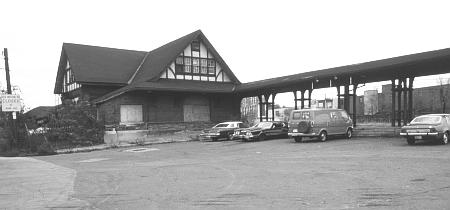“The Junction” is where the CP [Canadian Pacific Railway] east-west mainline crosses the CN [Canadian National Railway] tracks in the west end of Toronto. The bridge crossing the CP line was once a great location for train-spotting. But that bridge was demolished in the early 1980′s. Also demolished, in 1982, much to the dismay of rail fans and historians, was the CP railroad station, built in 1911. [ text, and photo below, from www.boldts.net ] This is a photo of the CP West Toronto station, which was located at Dupont and Dundas (near the current Coffee Time).
The Junction derives its name from two native trails which intersected in the area prior to European settlement. The name took on additional meaning later, as it was near the junction of four railway lines in the area. The area that is now the Junction was primarily rural up until the 1870s. From 1857-1876, much of it was the site of the Carleton Race Course, owned by the Keele family. Following the arrival of the railways in the 1880s, the old racetrack and surrounding area were developed by Daniel Webster Clendenan, and the two main straightaways of the track are now High Park Avenue and Pacific Avenue.
The Village of West Toronto Junction was founded in 1884 at the intersection of Dundas and Keele Streets. In 1889, it merged with the nearby villages of Carleton and Davenport to become the Town of West Toronto Junction. It grew further, into the Town of Toronto Junction in 1892, then the City of West Toronto, before it was amalgamated with the City of Toronto in 1909.
The Junction was a manufacturing community that boomed during the late 1800s. Foundries, mills, wire factories, and industries began moving into the area. Other firms came because land, labour and taxes were cheaper than in Toronto, and the Canadian Pacific established a major operation there, establishing yards from Keele Street as far west as Scarlett Road. In addition, the town acquired an official port of entry in the 1890s, allowing nearby businesses to clear their goods locally instead of using the downtown Toronto port. These factors attracted immigrant or second generation workers to the area — Irish Catholics who moved from poor, crowded tenement housing in other areas of the city, immigrants from English industrial cities such as Birmingham and Manchester, and then from non-English speaking countries, including Italians, Poles, Macedonians and Croatians.
The Junction was prone to booms and busts during its tumultuous history. While the period between 1888 and 1890 was a prosperous one, the period between 1893 and 1900 saw significant poverty in the area due to an economic recession. The Long Depression brought the closing of factories and an end to construction in the area, and the municipality could not support its citizens because of a large civic debt. Toronto annexed The Junction in 1909.
Rail transportation, not water, was what manufacturers cared about: no major factory or industrial area lacked railroad access. Railroads dominated the freight business and shaped industrial patterns well into the 1920s. Trucks did not figure. By the 1920s, there were two main centers of manufacturing employment in Toronto: the industrial area along the waterfront and the newer cluster in West Toronto Junction. This major industrial suburb owed its name and existence to the intersection of lines operated by the Grand Trunk and Canadian Pacific.
Since annexation of the Junction by the city of Toronto, the two have gradually grown together, though Junction residents have retained their community identity and remained very loyal to the neighbourhood, despite further economic hardship. Indeed, the commercial stretch of Dundas Street was all but abandoned until quite recently. The prohibition law dissuaded restaurants from establishing themselves there, and bars were not permitted.
The late elimination of prohibition, in 1997, has had a positive effect on the community, however. Rapid gentrification has meant new chic restaurants and bars have opened up along Dundas Street, attracting young hipsters, while lower rents make the neighbourhood appealing to artists. Some see the Junction as the next big “hip place to live” with a surplus of vacated industrial space and warehouse loft conversion possibilities.
The Junction Triangle, bounded by Keele, St. Clair, and Dundas Streets, was for many decades the location of the Ontario Stockyards. For a time, this was Canada’s largest livestock market and the centre of Ontario’s meat-packing industry, and reinforced Toronto’s nickname as Hogtown. The Ontario Stockyards closed at this site in 1993 (moving to Cookstown, much further north of the city), and most of the meat-packing plants that surrounded it closed shortly thereafter. There are still some smaller meat-packing facilities in the area north of St. Clair.
The former Stockyards site is now the location of a large bloc of big-box stores, including Dominion, Home Depot, Canadian Tire, Future Shop and Rona, along with several smaller stores. The name “Stockyards” is still used to describe this new shopping area. Immediately surrounding the retail core, new residential developments, primarily mid-to-upscale row houses, are revitalizing this neighbourhood. Many residents now fear continued gentrification, as wealthy or pseudo-poor (middle-class earners who live as and identify with low-income residents) Torontonians move into the area.
Since the early 1920s, the area by Dundas and St. John’s Road has been known as “Little Malta” (getting signs to that effect in the 1990s) with several Maltese-Canadian businesses present, as well as a distinctly Maltese church.
[ This is a slightly abbreviated version of the Wikipedia article -- please see http://en.wikipedia.org/wiki/The_Junction for more information and other links -- and a paragraph from Unplanned Suburbs by Richard Harris, JHU Press, 1999. -- Eleanor = eob at post dot harvard dot edu ]
Some other links:
A realtor’s view — http://www.torontolife.com/guide/rea…junction-area/
A History of the 40 Junction Trolley Bus — http://transit.toronto.on.ca/bus/routes/40-junction.shtml
Demographic statistics — http://www.toronto.ca/demographics/c…iles/cns90.htm


Recent Comments